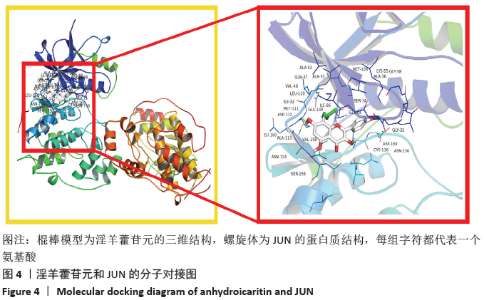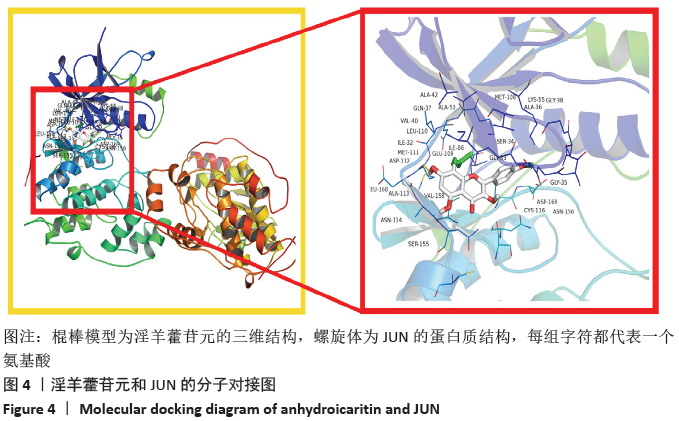Chinese Journal of Tissue Engineering Research ›› 2021, Vol. 25 ›› Issue (23): 3704-3710.doi: 10.12307/2021.043
Previous Articles Next Articles
Molecular mechanism of anhydroicaritin in the treatment of osteoarthritis: an analysis based on network pharmacology and bioinformatics
Chen Feng1, Zhang Xiaoyun1, 2, Chen Yueping1, Liao Jianzhao1, Li Jiajun1, Song Shilei1, Lai Yu1
- 1Department of Orthopedics, Ruikang Hospital, Guangxi University of Chinese Medicine, Nanning 530011, Guangxi Zhuang Autonomous Region, China; 2Jiangxi University of Traditional Chinese Medicine, Nanchang 330004, Jiangxi Province, China
-
Received:2020-05-27Revised:2020-05-29Accepted:2020-06-29Online:2021-08-18Published:2021-02-24 -
Contact:Zhang Xiaoyun, MD candidate, Department of Orthopedics, Ruikang Hospital, Guangxi University of Chinese Medicine, Nanning 530011, Guangxi Zhuang Autonomous Region, China; Jiangxi University of Traditional Chinese Medicine, Nanchang 330004, Jiangxi Province, China -
About author:Chen Feng, Master candidate, Department of Orthopedics, Ruikang Hospital, Guangxi University of Chinese Medicine, Nanning 530011, Guangxi Zhuang Autonomous Region, China -
Supported by:the National Natural Science Foundation of China, No. 81760796 and 81960803; Guangxi Natural Science Foundation for the Youth, No. 2020GXNSFBA159053 (to ZXY); Young Teachers' Basic Ability Improvement Project of Guangxi Universities, No. 2019KY0352; 2019 School-level Scientific Research Project of Guangxi University of Chinese Medicine, No. 2019QN027; First-class Subject Project of Guangxi University of Chinese Medicine, No. 2019XK026 and 2019XK029; Chongzuo Municipal Science and Technology Plan Project, No. FC2019006; 2016 National Famous Traditional Chinese Medicine Inheritance Studio Construction Project, No. {2016} 11; Qihuang Engineering Project for High-level Talent Team Cultivation of Guangxi University of Chinese Medicine, No. 04B1804804
CLC Number:
Cite this article
Chen Feng, Zhang Xiaoyun, Chen Yueping, Liao Jianzhao, Li Jiajun, Song Shilei, Lai Yu. Molecular mechanism of anhydroicaritin in the treatment of osteoarthritis: an analysis based on network pharmacology and bioinformatics[J]. Chinese Journal of Tissue Engineering Research, 2021, 25(23): 3704-3710.
share this article
Add to citation manager EndNote|Reference Manager|ProCite|BibTeX|RefWorks
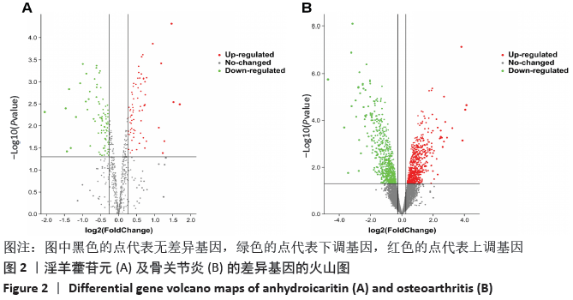
2.1 淫羊藿苷元ADME参数的评价 通过TCMSP数据库对淫羊藿苷元ADME相关参数进行研究,结果显示淫羊藿苷元的OB值为45.41%、DL值为0.44,远高于标准,说明淫羊藿苷元具有成为药物分子的巨大潜能。 2.2 淫羊藿苷元和骨关节炎作用靶点的筛选 利用R语言等软件对芯片矩阵文件和芯片基因注释文件进行分析,其中淫羊藿苷元干预的MCF7细胞和对照细胞共获得152个明显影响和改变的基因,在152个差异基因中上调基因72个、下调基因80个;分析骨关节炎患者和健康对照的外周血液共获得1 142个明显影响和改变的基因,在1 142个差异基因中上调基因660个、下调基因482个。将2组差异基因分别绘制成火山图,见图2。 "
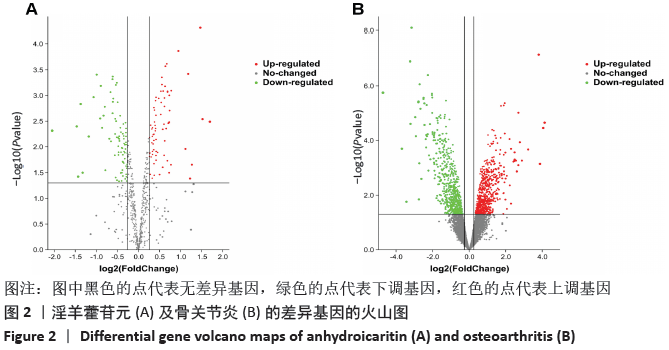
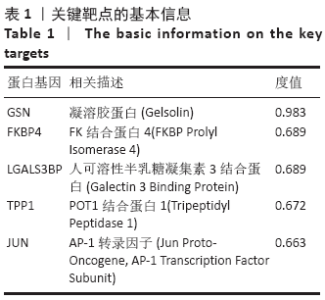
2.3 构建PPI网络和关键靶点的筛选 为进一步探究淫羊藿苷元对骨关节炎的药理机制,利用GeneMANIA数据库分别构建淫羊藿苷元和骨关节炎的PPI网络图,挖掘出淫羊藿苷元蛋白互作网络靶点172个、靶点之间的相互联系 5 924种;同时挖掘出骨关节炎蛋白互作网络靶点1 244个、靶点之间的相互联系79 186种。最后运用R语言合并映射PPI网络,分析淫羊藿苷元与骨关节炎的差异基因之间的互作关系,共获得44个差异基因、1 657种联系。在上述靶蛋白及其相互作用蛋白中,85.86%的目标具有共表达特征、8.36%的目标具有预测作用、3.62%的目标具有共定位特征、1.68%的目标具有物理互作、0.49%的目标具有信号通路特征,见图3。而在整个网络中,目标的度值越高,起到的作用越大,可能是淫羊藿苷元治疗骨关节炎的关键靶点。度值排名前5的蛋白基因为GSN、FKBP4、LGALS3BP、TPP1、JUN,其基本信息见表1。 "
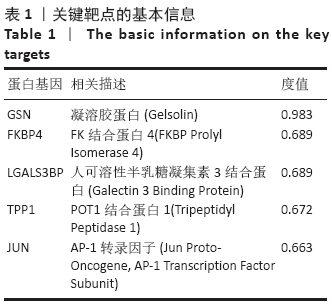
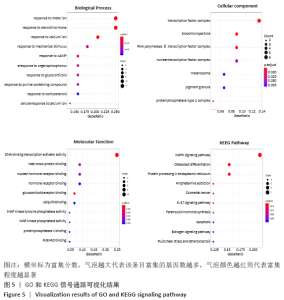
2.5 GO富集分析和KEGG富集分析 为探究更具体的功能模式,利用DAIVD数据库对探究上述44个关键基因进行GO和KEGG富集分析。GO富集分析共得到GO条目229个(P < 0.05),其中生物过程(BP)条目202个、细胞成分(CC)条目7个、分子功能(MF)条目20个,KEGG富集分析共得到13条信号通路,根据P值排序,选取P值最显著的前10个条目以气泡图的形式展现(不足则选取全部),见图5。分析结果显示,生物过程的相关条目主要包括对钙离子及金属离子的反应、对类固醇激素的反应、对有机磷的反应;细胞成分的相关条目主要包括转录因子复合物、血液微粒、RNA聚合酶Ⅱ转录因子复合物等;分子功能的相关条目主要包括DNA结合转录激活剂活性、热休克蛋白结合、核激素受体结合等;信号通路主要涉及MAPK信号通路、破骨细胞分化通路、PI3K-AKT信号通路、白细胞介素17(interleukin 17,IL?17)信号通路等。 "
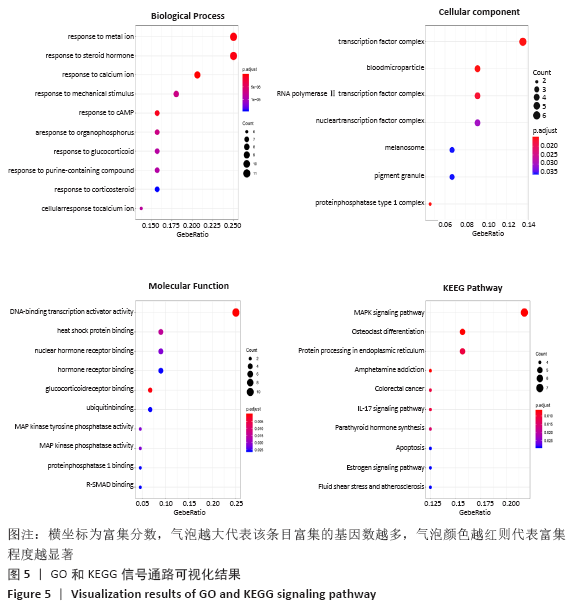
| [1] BRUYÈRE O, COOPER C, ARDEN N, et al. Can we identify patients with high risk of osteoarthritis progression who will respond to treatment? A focus on epidemiology and phenotype of osteoarthritis.Drugs Aging. 2015;32(3):179-187. [2] LIU B, JI C, SHAO Y, et al. Etoricoxib decreases subchondral bone mass and attenuates biomechanical properties at the early stage of osteoarthritis in a mouse model. BiomedPharmacother. 2020;127:110144. [3] SPITAELS D, MAMOURIS P, VAES B, et al. Epidemiology of knee osteoarthritis in general practice: a registry-based study. BMJ Open. 2020;10(1):e031734. [4] SUCHTING R, COLPO GD, ROCHA NP, et al. The Effect of Transcranial Direct Current Stimulation on Inflammation in Older Adults With Knee Osteoarthritis: A Bayesian Residual Change Analysis. Biol Res Nurs. 2020;22(1):57-63. [5] 汤化琪.玄胡索散成分分析及其治疗骨关节炎作用机制的网络药理学研究[D]. 北京:北京中医药大学,2017. [6] MATSUMOTO H, HAGINO H, HAYASHI K, et al. The effect of balneotherapy on pain relief, stiffness, and physical function in patients with osteoarthritis of the knee: a meta-analysis. ClinRheumatol. 2017; 36(8):1839-1847. [7] 邓凯烽,陈日兰,朱圣旺,等.电针结合雷火灸治疗寒湿型膝骨性关节炎的临床随机对照试验[J].中国组织工程研究, 2020,24(29):4638-4642. [8] ZHAO J, WANG Q, WU J, et al. Therapeutic effects of low-frequency phonophoresis with a Chinese herbal medicine versus sodium diclofenac for treatment of knee osteoarthritis: a double-blind, randomized, placebo-controlled clinical trial. J Tradit Chin Med. 2016;36(5):613‐617. [9] 章晓云,张驰,宋世雷,等.基于网络药理学和蛋白模块分析淫羊藿治疗骨关节炎的作用与机制[J].中国组织工程研究, 2020,24(17):2660-2666. [10] NGUYEN VS, SHI L, WANG SC, et al. Synthesis of Icaritin and β-anhydroicaritinMannich Base Derivatives and Their Cytotoxic Activities on Three Human Cancer Cell Lines. Anticancer Agents Med Chem. 2017; 17(1):137-142. [11] HASSANI D, FU X, SHEN Q, et al. Parallel Transcriptional Regulation of Artemisinin and Flavonoid Biosynthesis. Trends Plant Sci. 2020;25(5):466-476. [12] HUANG XF, CHENG WB, JIANG Y, et al. A network pharmacology-based strategy for predicting anti-inflammatory targets of ephedra in treating asthma.IntImmunopharmacol. 2020;83:106423. [13] LI J, ZHAO P, LI Y, et al. Systems Pharmacology-Based Dissection of Mechanisms of Chinese Medicinal Formula BufeiYishen as an Effective Treatment for Chronic Obstructive Pulmonary Disease. Sci Rep. 2015;5:15290. [14] MONTOJO J, ZUBERI K, RODRIGUEZ H, et al. GeneMANIA: Fast gene network construction and function prediction for Cytoscape. F1000Res. 2014;3:153. [15] 刘乐平,龙茜,曹学帅,等.基于网络药理学和分子对接法探寻麻杏薏甘汤治疗新型冠状病毒肺炎(COVID-19)活性化合物的研究[J].中草药,2020,51(7):1741-1749. [16] 章晓云,张驰,宋世雷,等.基于网络药理学和蛋白模块探讨淫羊藿治疗股骨头坏死的机制研究[J].中药材,2019(12): 2905-2914. [17] COWAN KJ, KLEINSCHMIDT-DÖRR K, GIGOUT A, et al. Translational strategies in drug development for knee osteoarthritis. Drug Discov Today. 2020;S1359-6446(20)30122-7. [18] WALKER C, BIASUCCI LM. Cardiovascular safety of non-steroidal anti-inflammatory drugs revisited. Postgrad Med. 2018;130(1): 55-71. [19] 余绍涌,刘建航,章晓云,等.淫羊藿苷治疗骨性关节炎过程中对关节软骨、软骨下骨、滑膜等影响的机制[J].中国组织工程研究,2020,24(14):2243-2249. [20] 李睿,杨信信,张小辉,等.淫羊藿苷治疗骨性关节炎的研究进展[J].中国骨质疏松杂志,2018,24(8):1088-1092. [21] 段荔.吴生元辨治OA用药规律及益气养血方抗OA体外机制研究[D].昆明:云南中医药大学,2019. [22] 赵晓燕.淫羊藿苷对人骨关节炎软骨细胞增殖凋亡的影响[J].海南医学,2018,29(1): 10-13. [23] 汪建样,殷嫦嫦,武翠翠,等.淫羊藿素通过Wnt/β-catenin信号通路促进BMSCs成软骨分化[J].中国中药杂志,2016,41(4): 694-699. [24] WANG ZC, SUN HJ, LI KH, et al. Icariin promotes directed chondrogenic differentiation of bone marrow mesenchymal stem cells but not hypertrophy in vitro. ExpTherMed. 2014; 8(5):1528-1534. [25] PARRA S, HERAS M, HERRERO P, et al. Gelsolin: a new biomarker of disease activity in SLE patients associated with HDL-c. Rheumatology (Oxford). 2020;59(3): 650-661. [26] 陈琦.重度烧伤小鼠凝溶胶蛋白变化规律及其对T细胞免疫功能影响的研究[D].北京:中国人民解放军医学院,2019. [27] PIKTEL E, WNOROWSKA U, CIEŚLUK M, et al. Recombinant Human Plasma Gelsolin Stimulates Phagocytosis while Diminishing Excessive Inflammatory Responses in Mice with Pseudomonas aeruginosa Sepsis. Int J Mol Sci. 2020;21(7):2551. [28] 曹国平. 基于FKBPs/GR/BDNF通路探讨逍遥散对抑郁模大鼠海马神经可塑性损伤修复的机制研究[D].广州:广州中医药大学,2017. [29] 高歌.网络药理学方法探讨川续断皂苷Ⅵ诱导间充质干细胞成骨分化[D].长春:吉林大学,2019. [30] STAMPOLIDIS P, ULLRICH A, IACOBELLI S. LGALS3BP, lectin galactoside-binding soluble 3 binding protein, promotes oncogenic cellular events impeded by antibody intervention. Oncogene. 2015;34(1)39‐52. [31] 王丹.一个新的TPP1相互作用蛋白OTUB1参与端粒长度调节的作用研究[D].广州:中山大学,2013. [32] MULLINS MR, RAJAVEL M, HERNANDEZ-SANCHEZ W, et al. POT1-TPP1 Binding and Unfolding of Telomere DNA Discriminates against Structural Polymorphism. J MolBiol. 2016;428(13):2695-2708. [33] XING Y, SHEPHERD N, LAN J, et al. MMPs/TIMPs imbalances in the peripheral blood and cerebrospinal fluid are associated with the pathogenesis of HIV-1-associated neurocognitive disorders. Brain BehavImmun. 2017;65:161-172. [34] 陈少华,李拾林.关节腔内注射雷公藤甲素治疗胶原诱导关节炎大鼠的实验研究[J].川北医学院学报,2020,35(1):6-9. [35] KHAN NM, HASEEB A, ANSARI MY, et al. Dataset of effect of Wogonin, a natural flavonoid, on the viability and activation of NF-κB and MAPKs in IL-1β-stimulated human OA chondrocytes. Data Brief. 2017;12: 150-155. [36] ZUPAN J, KOMADINA R, MARC J. The relationship between osteoclastogenic and anti-osteoclastogenic pro-inflammatory cytokines differs in human osteoporotic and osteoarthritic bone tissues. Biomed Sci. 2012;19(1):28. [37] SHI C, LI Z, WU Y, et al. Euscaphic acid and Tormentic acid protect vascular endothelial cells against hypoxia-induced apoptosis via PI3K/AKT or ERK 1/2 signaling pathway. Life Sci. 2020;252:117666. [38] 潘勇,祝健,卢华斌.白细胞介素-6、白细胞介素-17、白细胞介素-23与膝骨关节炎患者病情活动的相关性研究[J].中国卫生检验杂志,2018,28(11): 1395-1396, 1400. |
| [1] | Hu Kai, Qiao Xiaohong, Zhang Yonghong, Wang Dong, Qin Sihe. Treatment of displaced intra-articular calcaneal fractures with cannulated screws and plates: a meta-analysis of 15 randomized controlled trials [J]. Chinese Journal of Tissue Engineering Research, 2021, 25(9): 1465-1470. |
| [2] | Huang Dengcheng, Wang Zhike, Cao Xuewei. Comparison of the short-term efficacy of extracorporeal shock wave therapy for middle-aged and elderly knee osteoarthritis: a meta-analysis [J]. Chinese Journal of Tissue Engineering Research, 2021, 25(9): 1471-1476. |
| [3] | Xu Feng, Kang Hui, Wei Tanjun, Xi Jintao. Biomechanical analysis of different fixation methods of pedicle screws for thoracolumbar fracture [J]. Chinese Journal of Tissue Engineering Research, 2021, 25(9): 1313-1317. |
| [4] | Jiang Yong, Luo Yi, Ding Yongli, Zhou Yong, Min Li, Tang Fan, Zhang Wenli, Duan Hong, Tu Chongqi. Von Mises stress on the influence of pelvic stability by precise sacral resection and clinical validation [J]. Chinese Journal of Tissue Engineering Research, 2021, 25(9): 1318-1323. |
| [5] | Zhang Tongtong, Wang Zhonghua, Wen Jie, Song Yuxin, Liu Lin. Application of three-dimensional printing model in surgical resection and reconstruction of cervical tumor [J]. Chinese Journal of Tissue Engineering Research, 2021, 25(9): 1335-1339. |
| [6] | Zhang Yu, Tian Shaoqi, Zeng Guobo, Hu Chuan. Risk factors for myocardial infarction following primary total joint arthroplasty [J]. Chinese Journal of Tissue Engineering Research, 2021, 25(9): 1340-1345. |
| [7] | Wei Wei, Li Jian, Huang Linhai, Lan Mindong, Lu Xianwei, Huang Shaodong. Factors affecting fall fear in the first movement of elderly patients after total knee or hip arthroplasty [J]. Chinese Journal of Tissue Engineering Research, 2021, 25(9): 1351-1355. |
| [8] | Wang Jinjun, Deng Zengfa, Liu Kang, He Zhiyong, Yu Xinping, Liang Jianji, Li Chen, Guo Zhouyang. Hemostatic effect and safety of intravenous drip of tranexamic acid combined with topical application of cocktail containing tranexamic acid in total knee arthroplasty [J]. Chinese Journal of Tissue Engineering Research, 2021, 25(9): 1356-1361. |
| [9] | Xiao Guoqing, Liu Xuanze, Yan Yuhao, Zhong Xihong. Influencing factors of knee flexion limitation after total knee arthroplasty with posterior stabilized prostheses [J]. Chinese Journal of Tissue Engineering Research, 2021, 25(9): 1362-1367. |
| [10] | Peng Zhihao, Feng Zongquan, Zou Yonggen, Niu Guoqing, Wu Feng. Relationship of lower limb force line and the progression of lateral compartment arthritis after unicompartmental knee arthroplasty with mobile bearing [J]. Chinese Journal of Tissue Engineering Research, 2021, 25(9): 1368-1374. |
| [11] | Huang Zexiao, Yang Mei, Lin Shiwei, He Heyu. Correlation between the level of serum n-3 polyunsaturated fatty acids and quadriceps weakness in the early stage after total knee arthroplasty [J]. Chinese Journal of Tissue Engineering Research, 2021, 25(9): 1375-1380. |
| [12] | Zhang Chong, Liu Zhiang, Yao Shuaihui, Gao Junsheng, Jiang Yan, Zhang Lu. Safety and effectiveness of topical application of tranexamic acid to reduce drainage of elderly femoral neck fractures after total hip arthroplasty [J]. Chinese Journal of Tissue Engineering Research, 2021, 25(9): 1381-1386. |
| [13] | Wang Haiying, Lü Bing, Li Hui, Wang Shunyi. Posterior lumbar interbody fusion for degenerative lumbar spondylolisthesis: prediction of functional prognosis of patients based on spinopelvic parameters [J]. Chinese Journal of Tissue Engineering Research, 2021, 25(9): 1393-1397. |
| [14] | Lü Zhen, Bai Jinzhu. A prospective study on the application of staged lumbar motion chain rehabilitation based on McKenzie’s technique after lumbar percutaneous transforaminal endoscopic discectomy [J]. Chinese Journal of Tissue Engineering Research, 2021, 25(9): 1398-1403. |
| [15] | Chen Xinmin, Li Wenbiao, Xiong Kaikai, Xiong Xiaoyan, Zheng Liqin, Li Musheng, Zheng Yongze, Lin Ziling. Type A3.3 femoral intertrochanteric fracture with augmented proximal femoral nail anti-rotation in the elderly: finite element analysis of the optimal amount of bone cement [J]. Chinese Journal of Tissue Engineering Research, 2021, 25(9): 1404-1409. |
| Viewed | ||||||
|
Full text |
|
|||||
|
Abstract |
|
|||||


